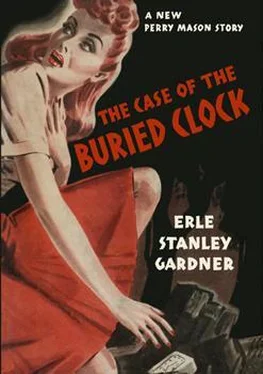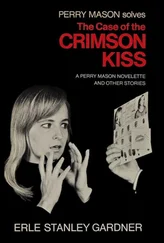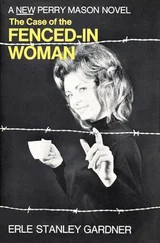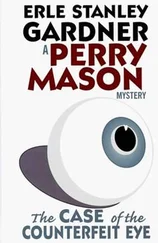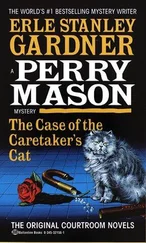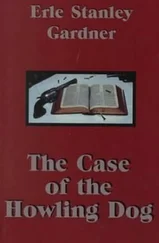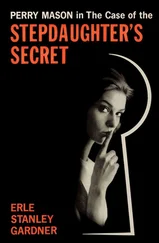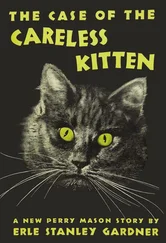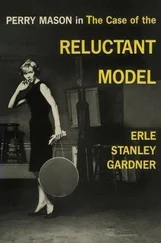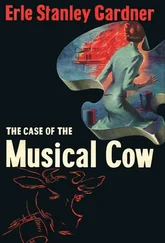She was close to tears now. “He said he had not seen my sister.”
“Cross-examine,” McNair snapped at Mason.
“No questions,” Mason said with calm dignity.
Then McNair apparently went off on a detour. He began introducing evidence concerning the spade which belonged to Jack Hardisty. A witness testified that he had seen Hardisty using a spade in the garden. Was there anything peculiar about that spade, anything distinctive, McNair asked? And the witness stated that he had noticed the initials J. H. cut in the wood.
Would the witness know that spade if he saw it again?
The witness thought he would.
With something of a flourish, McNair sent an attendant scurrying to an anteroom. He returned with a spade which was duly presented to the witness for identification.
Yes, that was the spade. Those were the initials. He was satisfied that that was the identical spade he had seen in Jack Hardisty’s hands.
There was no cross-examination.
McNair looked at the clock. It was approaching the hour of the afternoon adjournment. Obviously, McNair was looking for some peculiarly dramatic bit of evidence with which to close the first day’s evidence.
“Charles Renfrew,” he called.
Charles Renfrew proved to be a man in the early fifties, slow and deliberate of speech and motion, a man who quite evidently had no terror of cross-examination, but considered his sojourn on the witness stand with the satisfaction of a man who enjoys being in the public eye.
He was, it seemed, a member of the police force of Roxbury. He had searched the grounds about the house where the defendant, Dr. Jefferson Macon, had his residence and his office.
McNair said, “Mr. Renfrew, I am going to show you a spade which has been marked for identification in this case, and ask you if you have seen that spade before.”
“That’s right,” Renfrew said. “I found that spade—”
“The question was whether you had seen it before,” McNair interrupted.
“Yes, sir. I have seen it before.”
“When?”
“That day I made the search, October third.”
“ Where did you see it?”
“In a freshly spaded-up garden patch back of the garage on Dr. Macon’s property.”
“And you’re certain this is the same spade you found at that place at that time?”
“Yes, sir.”
McNair’s smile was triumphant. “You don’t, of course, know how this spade was transported from that mountain cabin to Dr. Macon’s residence?”
Mason said, “Objected to, Your Honor, assuming a fact not in evidence as well as calling for a conclusion of the witness. There is no evidence that this was the spade Jack Hardisty had in his car.”
McNair said instantly, “Counsel is right, Your Honor, I’ll prove that tomorrow. In the meantime, I’ll withdraw this question.” He flashed a smile at the jurors.
Once more there was no cross-examination.
McNair went rapidly ahead. Rodney Beaton told of seeing the defendant, Milicent Hardisty, standing near the edge of a barranca by the roadway, some object in her hand, her arm drawn back. He couldn’t swear, he admitted, that she had actually thrown this object down the barranca. She might have changed her mind at the last minute. He also testified that the next day he and Lola Strague had been searching the vicinity of the granite outcropping. They had found a thirty-eight caliber revolver pressed down in the pine needles. He identified the gun.
Mason made no cross-examination.
Lola Strague, called as a witness, also told of finding the gun, and identified it. Then McNair, with a dramatic gesture, introduced in evidence records that showed this gun had been purchased by Vincent P. Blane two days before Christmas of 1941.
At that point McNair looked at the clock significantly and Judge Canfield, taking the hint, announced that it had reached the usual hour for the evening adjournment.
McNair left the courtroom wearing an expression of complete self-satisfaction wreathed all over his countenance. His exit was punctuated by brilliant flashes as news photographers took action shots for the morning editions.
McNair started his second day of taking testimony with a technique that left no doubt he was deliberately building this case upon a series of dramatic climaxes. Court attachés and jurors, who had become accustomed to the conventional dry-as-dust method of building a murder case from accusation to conviction, began to throng the courtroom, attracted by this dynamic personality, who was, for the moment, presenting so colorful a figure.
William L. Frankline was McNair’s first witness of the day. Frankline, it seemed, was the deputy who had been with Jameson at the time Dr. Macon had been surprised at the Blane cabin, and Frankline testified in detail to steps they had taken to place the cabin under surveillance, and to seeing Adele Blane and Myrna Payson enter the cabin. Subsequently, Rodney Beaton and Lola Strague had arrived, and Adele had secreted herself in the dark bedroom where the body of Jack Hardisty had been found. Thereafter, Burt Strague had put in an appearance. Some minutes later, a skulking figure had been seen prowling around toward the back of the cabin. Having ascertained that the bedroom was dark, and apparently deserted, this figure had forced the window and entered the room. At that point the witness and one William N. Jameson, also a deputy sheriff, had approached the window, and at a signal simultaneously switched on flashlights, which had disclosed Adele Blane rushing screaming from the room, and the defendant, Dr. Macon, in the act of taking a bullet from its place of concealment behind a picture which hung on the wall of the bedroom. The bullet had been taken from Dr. Macon’s hand as the handcuffs were put on him, and subsequently marked with a distinctive scratch for identification. And the witness unhesitatingly identified the bullet which McNair showed him as being that bullet.
“Cross-examine,” McNair said to Perry Mason.
Mason regarded the witness thoughtfully. “You say that when you turned on your flashlights you saw this man in the act of removing a bullet from behind a picture?”
“Yes, sir.”
Mason said, “In other words, you saw his hand behind the framed picture. When you jerked the hand out you found there was a bullet in it, and from that, you deduced that he was removing a bullet from behind the picture. Is that right?”
“Well — you might put it that way.”
“And for all you know,” Mason said, “the defendant, Macon, instead of taking something out, may have been—” Mason broke off abruptly as his eye caught the smirk on McNair’s face. “I’ll withdraw that question,” he said calmly, “and there are no further questions of this witness.”
McNair was suddenly furious. He started to get up, apparently to make some objection, then dropped back into his chair. He frowned thoughtfully.
Mason drew toward himself a pad of paper, scribbled a note. “McNair wanted me to force Frankline to admit that Macon might have been putting the bullet in instead of taking it out. Something fishy here. Hold your hat.”
He walked over to hand the note to Della Street.
Judge Canfield looked at Dr. Macon. “Does the defendant, Macon, have any questions?”
“No questions.”
“Any redirect, Mr. McNair?”
“No... no, Your Honor. That’s all.” McNair seemed definitely nonplussed, but a moment later he called Dr. Kelmont Pringle.
Dr. Pringle qualified himself as an expert criminologist, laboratory technician, a specialist in forensic medicine and toxicology, and an expert on ballistics.
“Handing you the bullet which has previously been identified and received in evidence,” McNair said, “I will ask you if you examined that bullet and made certain tests with it.”
Читать дальше
